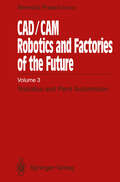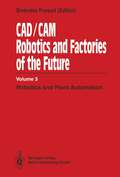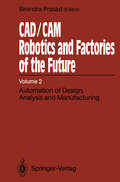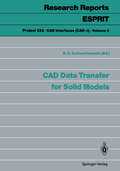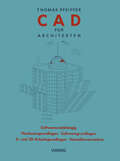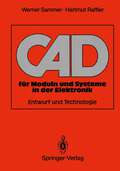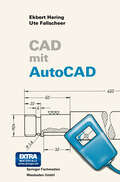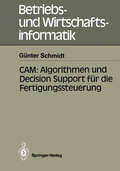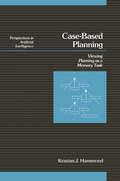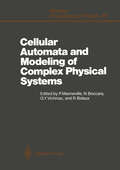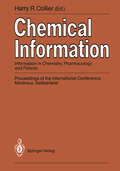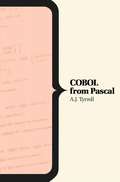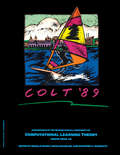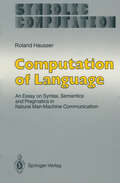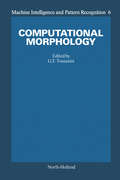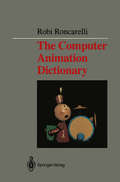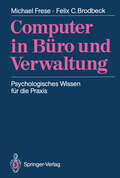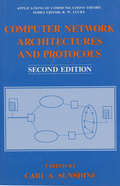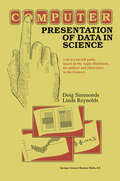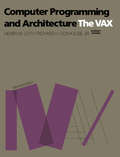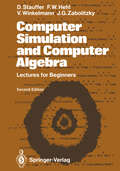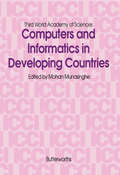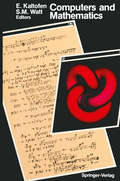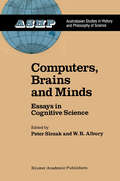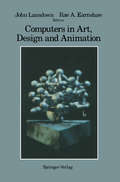- Table View
- List View
CAD/CAM Robotics and Factories of the Future: Volume III: Robotics and Plant Automation
by Birendra PrasadThe complete shop floor automation - a "lights out factory", where workers initially set up all machines, turn off the lights, lock the door and the machine churns up the parts - remains an unfulfilled dream. Yet when we look at the enormity of the process of automation and integration even for the most simply conceived part factory, we can recognize that automation has been applied and is being applied, more so when it made sense from a cost/benefit standpoint. It is our nature to be dissatisfied with near term progress, but when we realize how short a time the tools to do that automation have been available, the progress is clearly noteworthy - considering the multitudes of factors and the environment we have to deal with. Most of the automa tion problems we confront in today's environment are multidisciplinary in nature. They require not just the knowledge and experience in various distinct fields but good cooperation from different disci plined organizations to adequately comprehend and solve such problems. In Volume III we have many examples that reflect the current state of the art techniques of robotics and plant automation. The papers for Volume III have been arranged in a logical order of automation planning, automated assembly, robot programming and simula tion, control, motion coordination, communication and networking to factories of the future.
CAD/CAM Robotics and Factories of the Future: Volume III: Robotics and Plant Automation
by Birendra Prasad S. N. Dwivedi R. MahajanCAD/CAM Robotics and Factories of the Future: Volume II: Automation of Design, Analysis and Manufacturing
by Birendra PrasadThis volume is about automation - automation in design, automation in manufacturing, and automation in production. Automation is essen tial for increased productivity of quality products at reduced costs. That even partial or piecemeal automation of a production facility can deliver dramatic improvements in productivity has been amply demon strated in many a real-life situation. Hence, currently, great ef forts are being devoted to research and development of general as well special methodologies of and tools for automation. This volume re ports on some of these methodologies and tools. In general terms, methodologies for automation can be divided into two groups. There are situations where a process, whether open-loop or closed-loop, is fairly clearly understood. In such a situation, it is possible to create a mathematical model and to prescribe a mathe matical procedure to optimize the output. If such mathematical models and procedures are computationally tractable, we call the correspond ing automation - algorithmic or parametric programming. There is, however, a second set of situations which include process es that are not well understood and the available mathematical models are only approximate and discrete. While there are others for which mathematical procedures are so complex and disjoint that they are computationally intractable. These are the situations for which heuristics are quite suitable for automation. We choose to call such automation, knowledge-based automation or heuristic programming.
CAD Data Transfer for Solid Models (Research Reports Esprit #3)
by E. G. SchlechtendahlPrincipal authors: U. Kroszynski, B. Palstr9Sm 1.1 The evolution of concepts and specifications for CAD data exchange The CAD/CAM community has witnessed, during the last decade, the appearance of several specifications as well as proposals for standards which either attempt to cover wider areas or to be more reliable and stable than the others. With the rapid evolution of both hardware and software, the capabilities offered by CAD systems and CAD based application systems are far more advanced than they were only ten years ago, even when they are now based on micro-computers or personal comput ers. The situation with standards, however, is not and cannot be so. In order to be reliable and accepted by a wide community of both vendors and users, a standard has to be sta ble. This implies a life span of at least a decade. This also implies that the standard has to be general and flexible enough to accommodate present as well as expected future developments. 1.1.1 IGES The initial development of concepts for CAD data exchange is strongly influenced by the US Integrated Computer Aided Manufacturing (ICAM) programme, that dealt with the development of methods for data exchange. In September 1979, a subgroup was estab lished with participation of the National Bureau of Standards, the General Electric Com pany, and the Boeing Company. The result of this effort was the Initial Graphics Exchange Specification (IGES) that was published as a NBS report [61] in 1980.
CAD für Architekten: Hardwaregrundlagen, Softwaregrundlagen, 2 D-Arbeitstechniken, 3 D-Arbeitstechniken, CAD-Übungen
by Thomas PfeifferCAD für Moduln und Systeme in der Elektronik: Entwurf und Technologie
by Werner Sammer Hartmut RafflerDie hohe Komplexität elektronischer Moduln und Systeme, aber auch die immer kürzer werdenden Innovationszyklen machen den Einsatz rechnerunterstützter Entwurfsverfahren (CAD) unentbehrlich. Lagen die Entwicklungsschwerpunkte in früheren Jahren noch in der Technologie und in der Fertigung elektronischer Komponenten, so rücken heute die Entwurfsmethoden und -verfahren mit in den Vordergrund. Dies liegt auch darin begründet, daß die Wertschöpfung primär in der Verwendung elektronischer Komponenten geschieht. Gerade für die Erschließung neuer Anwendungen darf der Entwurf von elektronischen Moduln und Systemen nicht nur den auf dem Gebiet der Elektronik spezialisierten Ingenieuren vorbehalten bleiben. Ingenieure jeder Disziplin müssen durch entsprechende Entwurfssysteme in die Lage versetzt werden, elektronische Komponenten für ihren Anwendungsbereich entwickeln zu können. Diese Entwurfssysteme müssen den Anwender durch problemorientierte Darstellungsmittel, leistungsfähige Design- und Verifikationswerkzeuge und durch Werkzeuge zur Generierung von Schnittstellen zum Produktionsprozeß und zum Prüffeld unterstützen. Ziel dieses Buches ist es, einerseits Prinzipien, Methoden und Werkzeuge, die einem CAD-System für elektronische Moduln und Systeme zugrundeliegen, aufzuzeigen, andererseits aber auch Entwurfsverfahren zu diskutieren.
CAD mit AutoCAD: Eine umfassende Einführung für alle AutoCAD-Versionen einschließlich 9.0
by Ekbert HeringCAM: Algorithmen und Decision Support für die Fertigungssteuerung (Betriebs- und Wirtschaftsinformatik #36)
by Günter SchmidtFertigungsautomatisierung und die Realisierung fortgeschrittener Informationsverarbeitung sind wesentliche Voraussetzungen, um den Marktanforderungen für die Auftrags- und Kleinserienfertigung gerecht zu werden. Flexible Fertigungssysteme und CIM sind eine Antwort auf diese technologischen Herausforderungen. Intelligente Planungs- und Steuerungssysteme, eingebettet in das CIM-Konzept, zielen auf eine effiziente Nutzung der Möglichkeiten der flexiblen Automatisierung. Das vorliegende Buch gibt einen umfassenden Überblick über die in diesem Umfeld auftretenden Probleme und entsprechende Lösungsmöglichkeiten. Das Spektrum der dabei eingesetzten Werkzeuge reicht von der kombinatorischen Optimierung bis zu wissensbasierten Ansätzen. Der Leser, sei es der interessierte Praktiker, der Wissenschaftler oder der Student, findet neben einer Einführung in die methodischen Grundlagen eine Fülle von Anregungen und Beispielen für die Lösung von Planungs- und Steuerungsproblemen auf dem Hintergrund von Flexiblen Fertigungssystemen. Darüber hinaus wird ein CIM-gerechtes Leitstandsystem entworfen, das auf fortgeschrittenen konstruktiven und deskriptiven Lösungstechniken als integraler Bestandteil eines wissensbasierten Konzeptes aufbaut. Das Buch kann auf Grund seines Vorgehens und seines umfangreichen Quellenverzeichnisses sowohl als Lehrbuch wie auch als State of the Art Überblick genutzt werden.
Case-Based Planning: Viewing Planning as a Memory Task (Perspectives in Artificial Intelligence)
by Kristian J. HammondPerspectives in Artificial Intelligence, Volume 1: Case-Based Planning: Viewing Planning as a Memory Task focuses on the processes, methodologies, and techniques employed in viewing planning as a memory task. The publication first elaborates on planning and memory and learning from planning. Discussions focus on learning from cases, learning plans, learning to predict failures, case-based planning, structure of case-based planning, and learning from planning. The text then elaborates on planning from memory and planning Thematic Organization Packets (TOPs) and strategies, including TOPs in understanding and planning, TOPs and strategies, and function of memory. The manuscript takes a look at modifying and repairing plans, case-based planning, and planning and planners. Topics include CHEF as a program, case-based planning as planning and learning, noticing and explaining the failure, storing the plan, different situations for altering plans, and introduction of failure. The publication is a vital reference for researchers interested in viewing planning as a memory task.
Cellular Automata and Modeling of Complex Physical Systems: Proceedings of the Winter School, Les Houches, France, February 21–28, 1989 (Springer Proceedings in Physics #46)
by Paul Manneville Nino Boccara Gerard Y. Vichniac Roger BidauxCellular automata are fully discrete dynamical systems with dynamical variables defined at the nodes of a lattice and taking values in a finite set. Application of a local transition rule at each lattice site generates the dynamics. The interpretation of systems with a large number of degrees of freedom in terms of lattice gases has received considerable attention recently due to the many applications of this approach, e.g. for simulating fluid flows under nearly realistic conditions, for modeling complex microscopic natural phenomena such as diffusion-reaction or catalysis, and for analysis of pattern-forming systems. The discussion in this book covers aspects of cellular automata theory related to general problems of information theory and statistical physics, lattice gas theory, direct applications, problems arising in the modeling of microscopic physical processes, complex macroscopic behavior (mostly in connection with turbulence), and the design of special-purpose computers.
Chemical Information: Information in Chemistry, Pharmacology and Patents Proceedings of the International Conference, Montreux, Switzerland, September 1989
by Harry R. CollierThis volume contains the full text of twenty-six of the thirty-one papers given at the Montreux 1989 International Chemical Information Conference in Montreux, Switzerland between 26 and 28 September 1989. The five papers omitted were due to their late completion and subsequent unavailability for incorporation in this volume. Of the twenty-six papers included, all but three were delivered to Infonortics in diskette form between 1 July and 1 August 1989; by 17 August 1989 the 310 pages of text and figures were typeset and scanned graphics inserted. By 26 September 1989 all copies were printed in England and delivered to the Montreux Congress Centre in Switzerland. The rapid and efficient process reflects creditably on all parties concerned, especially on the authors who followed assiduously the detailed instructions concerning presentation they were given. Conventional publishing is not so rapid, but conventional publishing does give time for authors to proof-read their texts, make correc tions and add material, and gives time for the publisher to index the work thoroughly and completely. The current Proceedings have not been proof-read by the authors, nor is there an index. I hope that readers will appreciate this trade-off between currency and thoroughness and will recognise some of the limitations imposed by publishing proceedings at the same time the conference is held. H.R. Collier Infonortics Ltd., August 1989 Caine, Wiltshire, England v Table of Contents Chemical information as a commercial marketplace E. Garfield ..•.•.•••..........•.•...•............•.•...•.
COBOL From Pascal (Computer Science Series)
by A.J. TyrrellThis book is concerned with language skills and language understanding rather than programming methodology. No mention is made of testing, and no attention given to the environment in which programs must be entered, or executed. It is assumed that a reader will be familiar with these matters.
COLT '89: Proceedings of the Second Annual Workshop, UC Santa Cruz, California, July 31 - August 2 1989
by ColtComputational Learning Theory presents the theoretical issues in machine learning and computational models of learning. This book covers a wide range of problems in concept learning, inductive inference, and pattern recognition.Organized into three parts encompassing 32 chapters, this book begins with an overview of the inductive principle based on weak convergence of probability measures. This text then examines the framework for constructing learning algorithms. Other chapters consider the formal theory of learning, which is learning in the sense of improving computational efficiency as opposed to concept learning. This book discusses as well the informed parsimonious (IP) inference that generalizes the compatibility and weighted parsimony techniques, which are most commonly applied in biology. The final chapter deals with the construction of prediction algorithms in a situation in which a learner faces a sequence of trials, with a prediction to be given in each and the goal of the learner is to make some mistakes.This book is a valuable resource for students and teachers.
Computation of Language: An Essay on Syntax, Semantics and Pragmatics in Natural Man-Machine Communication (Symbolic Computation)
by Roland HausserThe study of linguistics has been forever changed by the advent of the computer. Not only does the machine permit the processing of enormous quantities of text thereby securing a better empirical foundation for conclusions-but also, since it is a modelling device, the machine allows the implementation of theories of grammar and other kinds of language processing. Models can have very unexpected properties both good and bad-and it is only through extensive tests that the value of a model can be properly assessed. The computer revolution has been going on for many years, and its importance for linguistics was recognized early on, but the more recent spread of personal workstations has made it a reality that can no longer be ignored by anyone in the subject. The present essay, in particular, could never have been written without the aid of the computer. I know personally from conversations and consultations with the author over many months how the book has changed. If he did not have at his command a powerful typesetting program, he would not have been able to see how his writing looked and exactly how it had to be revised and amplified. Even more significant for the evolution of the linguistic theory is the easy testing of examples made possible by the implementation of the parser and the computer-held lexicon. Indeed, the rule set and lexicon grew substantially after the successes of the early implementations created the desire to incorporate more linguistic phenomena.
Computational Morphology: A Computational Geometric Approach to the Analysis of Form (ISSN #Volume 6)
by G. T. ToussaintComputational Geometry is a new discipline of computer science that deals with the design and analysis of algorithms for solving geometric problems. There are many areas of study in different disciplines which, while being of a geometric nature, have as their main component the extraction of a description of the shape or form of the input data. This notion is more imprecise and subjective than pure geometry. Such fields include cluster analysis in statistics, computer vision and pattern recognition, and the measurement of form and form-change in such areas as stereology and developmental biology.This volume is concerned with a new approach to the study of shape and form in these areas. Computational morphology is thus concerned with the treatment of morphology from the computational geometry point of view. This point of view is more formal, elegant, procedure-oriented, and clear than many previous approaches to the problem and often yields algorithms that are easier to program and have lower complexity.
The Computer Animation Dictionary: Including Related Terms Used in Computer Graphics, Film and Video, Production, and Desktop Publishing
by Robi RoncarelliDr AIvy Ray Smith Executive Vice President, Pixar The pOlyglot language of computer animation has arisen piecemeal as a collection of terms borrowed from geometry, film, video, painting, conventional animation, computer graphiCS, computer science, and publishing - in fact, from every older art or science which has anything to do with pictures and picture making. Robi Roncarelli, who has already demonstrated his foresight by formally identifying a nascent industry and addressing his Computer Animation Newsletter to it, here again makes a useful contribution to it by codifying its jargon. My pleasure in reading his dictionary comes additionally from the many historical notes sprinkled throughout and from surprise entries such as the one referring to Zimbabwe. Just as Samuel Johnson's dictionary of the English language was a major force in stabilizing the spelling of English, perhaps this one will serve a similar purpose for computer animation. Two of my pets are "color" for "colour" and "modeling" "modelling", under the rule that the shorter accepted spelling is always preferable. [Robi, are you reading this?] [Yes, AIvy!] Now I commend this book to you, whether you be a newcomer or an oldtimer.
Computer in Büro und Verwaltung: Psychologisches Wissen für die Praxis
by Michael Frese Felix C. BrodbeckHier wird erstmals eine umfassende und verständliche Einführung in das komplexe Gebiet der Mensch-Computer-Interaktion in Büro und Verwaltung gegeben. Behandelt werden folgende Fragen: Wie kann man neue Kommunikationstechniken in die betriebliche Praxis integrieren? Wie können dabei die Kriterien humaner Arbeitsgestaltung berücksichtigt werden? Wie kann die Software-Gestaltung dahingehend optimiert werden? Wie sollte ein adäquates Training speziell für die Mensch-Computer-Interaktion aussehen? Welche sozialen Veränderungen werden durch die Einführung neuer Kommunikationstechniken erwartet? Das Buch bietet trotz seines Lehrbuchcharakters eine stark praxisorientierte Einführung in diesen Themenbereich.
Computer Network Architectures and Protocols (Applications of Communications Theory)
by Carl A. SunshineThis is a book about the bricks and mortar from which are built those edifices that will permeate the emerging information society of the future-computer networks. For many years such computer networks have played an indirect role in our daily lives as the hidden servants of banks, airlines, and stores. Now they are becoming more visible as they enter our offices and homes and directly become part of our work, entertainment, and daily living. The study of how computer networks function is a combined study of communication theory and computer science, two disciplines appearing to have very little in common. The modern communication scientist wishing to work in this area soon finds that solving the traditional problems of transmission, modulation, noise immunity, and error bounds in getting the signal from one point to another is just the beginning of the challenge. The communication must be in the right form to be routed properly, to be handled without congestion, and to be understood at various points in the network. As for the computer scientist, he finds that his discipline has also changed. The fraction of computers that belong to networks is increasing all the time. And for a typical single computer, the fraction of its execution load, storage occupancy, and system management problems that are in volved with being part of a network is also growing.
Computer Presentation of Data in Science: a do-it-yourself guide, based on the Apple Macintosh, for authors and illustrators in the Sciences
by D. Simmonds L. ReynoldsBooks about printing written for printers or would-be printers go back over 300 years. The earliest of them were almost exclusively concerned with books; this century, however, there has been more emphasis on other kinds of documents, and particularly their design. But no shift in document production has been more sudden than the one that has happened most recently. ConSequently, the last five years have witnessed a substantial movement away from books written for professionals to ones whose aim is to help would-be authors produce their own documents. The opportunities for authors to do this have been opened up by the advent of desktop publishing (a term coined as recently as 1984). As most exponents of desktop publishing have come to realise, the term is something of a misnomer because the provision of facilities that allow authors to produce their own material for publishing is not quite the same thing as publish ing. Nevertheless, it has been useful in focussing attention on author-produced documents, and what might be described as the democratisation of document production. This book is different from others in the field. Its target audience is the busy scientist engaged in teaching or research who uses computers in the ordinary course of work. The world of scientific publishing is rapidly moving towards the day when journals will expect contributions from authors on disc, or even by direct transfer of data from the author's computer to the output device of an editor via telephone and satellite.
Computer Programming and Architecture: The Vax
by Henry Levy Richard EckhouseTakes a unique systems approach to programming and architecture of the VAX Using the VAX as a detailed example, the first half of this book offers a complete course in assembly language programming. The second describes higher-level systems issues in computer architecture. Highlights include the VAX assembler and debugger, other modern architectures such as RISCs, multiprocessing and parallel computing, microprogramming, caches and translation buffers, and an appendix on the Berkeley UNIX assembler.
Computer Simulation and Computer Algebra: Lectures for Beginners
by Dietrich Stauffer Friedrich W Hehl Volker Winkelmann John G. ZabolitzkyThe chapter on statistical-physics simulations has been enlarged, mainly by a dis cussion of multispin coding techniques for the Ising model (bit-by-bit parallel oper ations). In the chapter about Reduce, some details of the presentation have been cor rected or clarified. The new operator MATEIGEN for the computation of eigenvec tors of matrices is explained. The first chapter and the appendix remain unchanged. Needless to say, the field of computational science is advancing so quickly, for ex ample with the development of parallel, as opposed to vectorized, algorithms, that it will not be too long before a further edition is called for. Cologne, March 1989 The authors Preface to the First Edition Computers play an increasingly important role in many of today's activities, and correspondingly physicists find employment after graduation in computer related jobs, often quite remote from their physics education. The present lectures, on the other hand, emphasize how we can use computers for the purposes of fundamental research in physics. Thus we do not deal with programs designed for newspapers, banks, or travel agencies, i.e., word processing and storage of large amounts of data.
Computers and Informatics in Developing Countries
by Mohan MunasingheComputers and Informatics in Developing Countries is a collection of papers documenting the conference of the Expert Group on Computers and Informatics for Development which investigates how the international scientific and development community can assist developing countries in using computer and informatics technology to promote progress and growth. The papers address the need for developing countries to formulate and apply computer and informatics policies for development, as well as the role of an International Centre for Computers and Informatics (ICCI) should play in the development process. The ICCI should be based on the network principle that links other regional and national computer centers. The advantages of the network principle are lower startup costs, avoidance of setting up a large organization, and localized services of needs. An international organization similar to ICCI can accelerate Third World developmental efforts following the identification of needs of developing countries as regards computer and informatics, setting of clear objectives of ICCI, and meeting with potential donors. The collection is suitable for heads of both non-government agencies and government departments involved in international aid, education, or development, and also to administrators of educational institutions and philanthropic organizations.
Computers and Mathematics
by Erich Kaltofen Stephen M. WattAdvances in computer technology have had a tremendous impact on mathematics in the last two decades. In June of 1989, an international conference was held at MIT, bringing together mathematicians and computer scientists, to survey the work that has been done in computational mathematics, to report recent results in this field, and to discuss research directions as well as educational issues. This book presents a fascinating collection of contributions on topics ranging from computational algebra, and parallel computing, to mathematics education. Mathematicians interested in the computational aspects of their discipline as well as computer scientists interested in mathematical applications will enjoy the integrative view provided by this book.
Computers, Brains and Minds: Essays in Cognitive Science (Studies in History and Philosophy of Science #7)
by P. Slezak W. R. AlburyThe institutionalization of History and Philosophy of Science as a distinct field of scholarly endeavour began comparatively early - though not always under that name - in the Australasian region. An initial lecturing appointment was made at the University of Melbourne imme diately after the Second World War, in 1946, and other appointments followed as the subject underwent an expansion during the 1950s and 1960s similar to that which took place in other parts of the world. Today there are major Departments at the University of Melbourne, the University of New South Wales and the University of Wollongong, and smaller groups active in many other parts of Australia and in New Zealand. "Australasian Studies in History and Philosophy of Science" aims to provide a distinctive publication outlet for Australian and New Zealand scholars working in the general area of history, philosophy and social studies of science. Each volume comprises a group of essays on a connected theme, edited by an Australian or a New Zealander with special expertise in that particular area. Papers address general issues, however, rather than local ones; parochial topics are avoided. Further more, though in each volume a majority of the contributors is from Australia or New Zealand, contributions from elsewhere are by no means ruled out. Quite the reverse, in fact - they are actively encour aged wherever appropriate to the balance of the volume in question.
Computers in Art, Design and Animation
by John Lansdown Rae EarnshawThe collection of papers that makes up this book arises largely from the joint activities of two specialist groups of the British Computer Society, namely the Displays Group and the Computer Arts Society. Both these groups are now more than 20 years old and during the whole of this time have held regular, separate meetings. In recent years, however, the two groups have held a joint annual meeting at which presentations of mutual interest have been given and it is mainly from the last two of these that the present papers have been drawn. They fall naturally into four classes: visualisation, art, design and animation-although, as in all such cases, the boundaries between the classes are fuzzy and overlap inevitably occurs. Visualisation The graphic potential of computers has been recognised almost since computing was first used, but it is only comparatively recently that their possibilities as devices for the visualisation of complex. and largely ab stract phenomena has begun to be more fully appreciated. Some workers stress the need to be able to model photographic reality in order to assist in this task. They look to better algorithms and more resolution to achieve this end. Others-Alan Mackay for instance-suggest that it is "not just a matter of providing more and more pixels. It is a matter of providing congenial clues which employ to the greatest extent what we already know.
